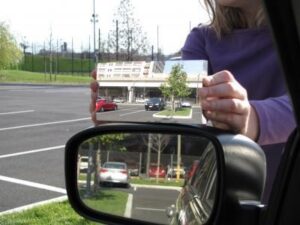
A side-by-side comparison of a standard flat driver’s side mirror with the mirror designed by Dr. R. Andrew Hicks, mathematics professor at Drexel University. With minimal distortion, Hicks’s mirror shows a much wider field of view (the wide area to the left of the silver car seen in the distance, behind the tree, in this image). Hicks’s mirror has a field of view of about 45 degrees, compared to 15 to 17 degrees of view in a flat mirror. Hicks’s mirror received a US patent in May 2012.
A side mirror that eliminates the dangerous “blind spot” for drivers has now received a U.S. patent. The subtly curved mirror, invented by Drexel University mathematics professor Dr. R. Andrew Hicks, dramatically increases the field of view with minimal distortion.
Traditional flat mirrors on the driver’s side of a vehicle give drivers an accurate sense of the distance of cars behind them but have a very narrow field of view. As a result, there is a region of space behind the car, known as the blind spot, that drivers can’t see via either the side or rear-view mirror. It’s not hard to make a curved mirror that gives a wider field of view; no blind spot; but at the cost of visual distortion and making objects appear smaller and farther away.
Hicks’s driver’s side mirror has a field of view of about 45 degrees, compared to 15 to 17 degrees of view in a flat driver’s side mirror. Unlike in simple curved mirrors that can squash the perceived shape of objects and make straight lines appear curved, in Hicks’s mirror the visual distortions of shapes and straight lines are barely detectable.
Hicks, a professor in Drexel’s College of Arts and Sciences, designed his mirror using a mathematical algorithm that precisely controls the angle of light bouncing off of the curving mirror.
“Imagine that the mirror’s surface is made of many smaller mirrors turned to different angles, like a disco ball,” Hicks said. “The algorithm is a set of calculations to manipulate the direction of each face of the metaphorical disco ball so that each ray of light bouncing off the mirror shows the driver a wide, but not-too-distorted, picture of the scene behind him.”
Hicks noted that, in reality, the mirror does not look like a disco ball up close. There are tens of thousands of such calculations to produce a mirror that has a smooth, nonuniform curve.
Hicks first described the method used to develop this mirror in Optics Letters in 2008
In the United States, regulations dictate that cars coming off of the assembly line must have a flat mirror on the driver’s side. Curved mirrors are allowed for cars’ passenger-side mirrors only if they include the phrase “Objects in mirror are closer than they appear.”
Because of these regulations, Hicks’s mirrors will not be installed on new cars sold in the U.S. any time soon. The mirror may be manufactured and sold as an aftermarket product that drivers and mechanics can install on cars after purchase. Some countries in Europe and Asia do allow slightly curved mirrors on new cars. Hicks has received interest from investors and manufacturers who may pursue opportunities to license and produce the mirror.
For more such insights, log into our website https://international-maths-challenge.com
Credit of the article given to Drexel University


